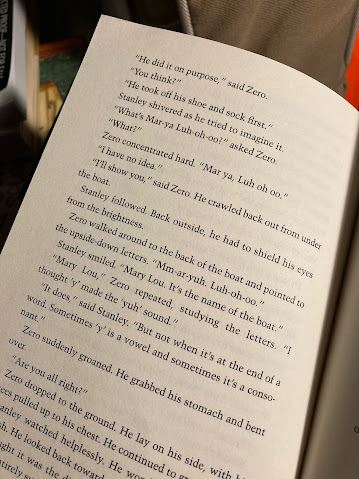Art Imitates Life: Reading Journal II
We were working on Louis Sachar's classic novel, Holes.
The novel features a formerly homeless teen, Zero, who has never learned to read. The main character, Stanley, ends up bonding with him as they work on literacy skills together.
Dear reader, this serves two purposes:
One, it reveals Stanley's empathy through his desire to help another youngster. Although the reading lessons are offered in exchange for manual labour, Stanley comes to realise that he could have offered the lessons without any conditions attached. It's an opportunity for the reader to observe his growing maturity and compassion as the book progresses. Having suffered through adversity and made an unexpected friend, he sheds his downtrodden, self-effacing persona and emerges as a confident, resilient and resourceful young man.
Two, these reading lessons teach the reader an important lesson: when you're at the bottom of a deep hole, no education is ever wasted. And without spoiling the book for you, I mean this literally. But the book is called Holes. It will come as no surprise to you that yes, the main character does indeed end up at the bottom of a big hole toward the end of the book and yes, he does escape. His exit and subsequent survival are owed to Zero's new skill as a reader. Still halting, still needing those 10,000 hours of practice to reach proficiency, but there is no question that he this once homeless and shoeless young man is - triumphantly, proudly, undoubtedly a reader.
Apart from these two lofty, literary purposes, I discovered a quiet, very personal kind of jubilation in it. You see, my student was dyslexic. This section of the book probably felt very familiar to him. His struggle to make sense of school, homework, the world. So much of it full of symbols that had to be decoded slowly, painstakingly, even when he had seen them countless times before. This child had enriched my second reading of Holes to no end. He was a chatty, upbeat, often hilarious little guy - not at all like Zero's withdrawn, wary character, but even so, his struggle to read must have been so tiring.
I don't suppose I'll ever know if Louis Sachar was thinking of his early days as a teacher's aide when he wrote this part of the story. It was tempting to Google "real life inspiration illiteracy theme Holes" to see if anyone had written about the topic. But only slightly. I preferred to enjoy this instance of art possibly, maybe imitating life and focus my attention on the student in front of me. After all, that's why I do this.
Which is why, instead of getting lost in an internet hole (pun intended) filled with monetised lesson plans, I just asked my student what he thought. I'll publish his answers in my next posting.
I guess that all that time lost in Sachar's wonderful writing has taught me a lesson, too - about cliffhangers.
See you soon.


Comments
Post a Comment